|
Thomas Lanigan-Schmidt at MoMA/PS1
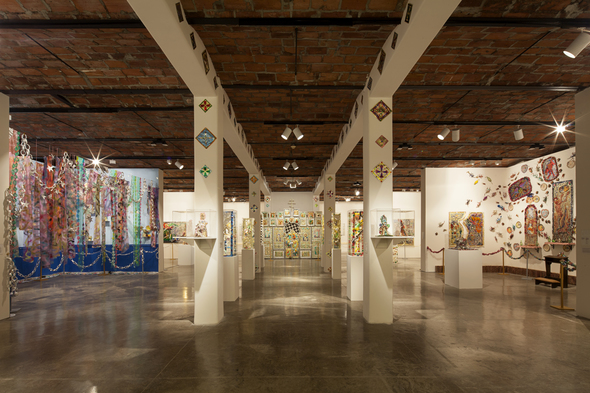
|
|
Thomas Lanigan-Schmidt: Tender Love Among The Junk (installation)
|
Entering this exhibition, which occupies one of
the larger spaces at MoMA/PS1, was overwhelming.
I don't think I've ever seen anything quite like
it. The entire space is filled with numerous,
mostly shiny artifacts, made of the most diverse
materials, mostly things one might obtain from a
99-cent store or a trash pile. Several themes and
concerns come together: formal pictorial and
plastic values; religious sensibility and
aesthetics; Gay and general sexuality; class
politics; diverse cultures; the conflicts and
cross-pollination between these elements.
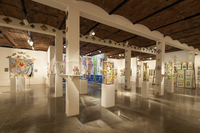
|
|
side view of exhibition
|
Artists have been using junk, detritus, trash, for a
long time. Usually, however, a particular point is
made of the junkiness of the junk. It is not supposed
to rise above its origins; in fact, the main point of
most of that kind of art has been specifically that
quality, used perhaps to criticize or deride 'society'
or 'modern life', to point out their brutality or
wastefulness, for example. Just the other day I was
looking at the work of an artist who does sensitive
portraits of broken television sets in what appear
to be the sort of damp suburban wooded areas where
people like to deposit such things along with other
household trash.

|
|
|
This is not that kind of junk; this is junk which has
been made to transcend junk, which has been rescued
and lifted up to a higher level, both as to its
formal properties and its meaning, its signification.
In that regard, maybe its closest famous relatives are
the shadow boxes of Joseph Cornell, another collector
and combiner of odds and ends. Like Cornell,
and unlike your average everyday trash-employing
artist, then, Lanigan-Schmidt appears to find real,
not ironic, value in the materials he works with.
When he employs irony, it is at a different level.
(I think this somewhat refutes a widespread take
on L-H's work: commenters have found it to be a
crossing of kitsch, pop (in the 'pop art' sense),
punk, and folk. Except in hard-core Outsider Art,
these styles, when used by present-day artists,
is almost always substantially if not entirely
ironic.)

|
|
|
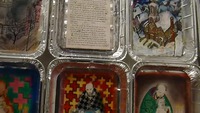
|
|
|
One of the obvious influences on Lanigan-Schmidt a sort of
combined influence of Roman Catholic and Eastern
Orthodox Christianity, the latter being perhaps
predominant in the Linden, New Jersey, of his
childhood. (When I first encountered this aspect
of his work I was sure it was specifically Eastern
Rite Catholicism, which combines both traditions in a
number of different ways.) We are not talking about
only iconography and decor here, although there is
plenty of that, but their practices and the social
meaning as well. It is evident that the artist experienced
a great deal of tension, internal and external, around the antisexual
(especially antihomosexual) attitudes taken by the
churches of his youth and his own sexuality, which he
understood to be Gay from an early age. Many people
have gone from one side to the other, and vehemently
rejected the side they came from. Evidently Lanigan-Schmidt
didn't do this. While he makes some fun of strict
nuns and depicts brutal street gangs doubtless
cheered on by parental and religious authority, he
does not reject the churches' humane and positive
social values. And so we have images of priests
baptizing infants, or of neighborhood churches in the
evening twilight, as well as depictions of violence
and oppression.

|
|
|
While the religiously themed material is overt and
given on its own terms, the sexual content seems
rather restrained (in spite of a sign warning us
at the front door that some of it is 'graphic').
However, it is certainly not hidden. Outside of
some humor, it is usually integrated into other
work. Some of it is selected from the rather
Arcadian soft-core pornography of yesteryear, but
it has undergone a kind of sublimation through the
same processes as the other material.
Lanigan-Schmidt, unlike many, appears to disdain
the now ancient clichéed demand to
épater les bourgeois however much
they may desire to be
épatéed -- a demand which often
had invited the use of pornography. Instead, the erotic
material is pretty seamlessly involved in the other
material, especially the religious. After all, it
is the erotic which first takes us out of ourselves.
However despised and humiliated, it, too, can
be lifted up.

|
|
|
The large room of the exhibition -- I should say
installation, for the entirety is well-designed
and coherent, for which the curator and assistant
curator, Peter Eleey and Jocelyn Miller, must
be honored -- was divided into bays, each one
differing from the next thematically. On the
immediate right going in were numerous drawings
on ordinary paper pasted into the bottoms of
aluminum baking pans; these turn out to be images
from a semi-autobiographical story. Some of these
are modest, fairly representational line drawings;
others are more surreal. Some seem to be versions
of others, either copied by hand or with an office
copier. At the center of each group is a handwritten
page containing the narrative which the surrounding
pictures illustrate or comment on. The story seems
to be semi-autobiographical.
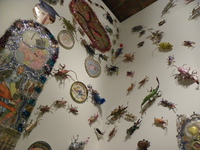
|
|
_caption_
|
In the next bay we meet some larger works including
glittering devils and skeletons, reminiscent of
Mexican calavera art, plus a great
profusion of what can only be called hypervermin --
lurid, shiny creatures which seem to be part rat,
part insect, part lizard, transformed from their lowly
estate into jewels without in any way losing their
proper creepiness (especially given their numbers
and the fact that a good many of them are overhead.)
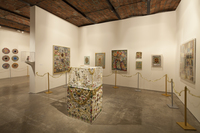
|
|
_caption_
|
In the next bay after that, the imagery turns more
religious; at the same time, often woven into the
religious imagery, some sexual themes emerge. Some of
these pictures are organized like comics in panels,
and textual material is interspersed with them.
'The prayer of sexuality / the sexuality of prayer'
one legend reads.

|
|
_caption_
|
In the back, on both sides, the works are more
abstract. There is a table with posters announcing
some exhibitions of installations the artist put
together in the 1960s.

|
|
_caption_
|
On the opposite wall, further toward the front, is
a subinstallation consisting of streamers, banners,
various objects such as chalices (a favorite theme)
and one as-yet untranscendent rat.
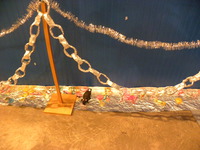
|
|
_caption_
|
This particular
subinstallation is about the size of an apartment room
and may, in fact, be a recollection of the artist's
first shows, which were given in his own apartment
to his friends and acquaintances.
Finally, on the same side, there is a sort of parody
of high-school art involving the strict nuns of the
artist's parochial school experiences, or at least
their mythic equivalents.
In the center of the room, towards the back, is an
ikonostasis (which Lanigan-Schmidt had to construct
in pieces, since his work space could not contain it
in final form) and behind that a similar assemblage of
religious works. Between the ikonostasis and the front
door are a number of free-standing three-dimensional
works, often lit from within. These usually are highly
baroque representations of objects of various kinds
like chalices and high-heeled women's shoes, although
some are more abstract.
The exhibition cannot be easily summed up; it is a
considerable experience, and I have only scratched
the surface here. It does leave one wondering why
Thomas Lanigan-Schmidt is not better known and more
widely exhibited and appreciated.
Links
|
